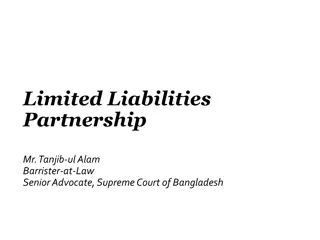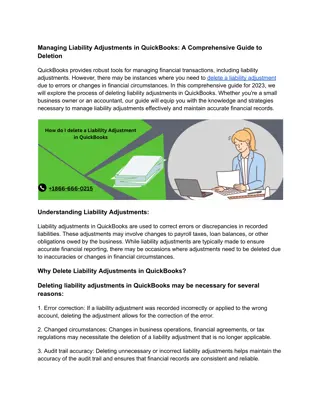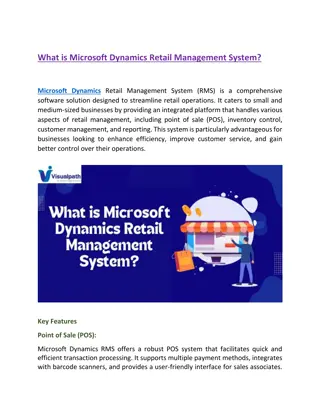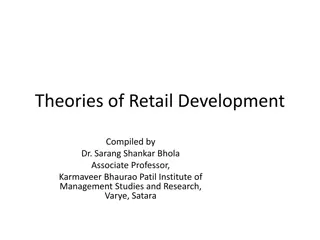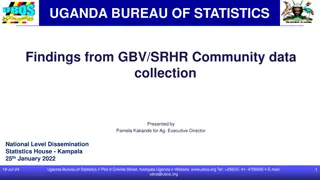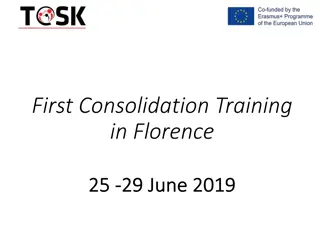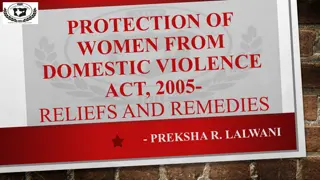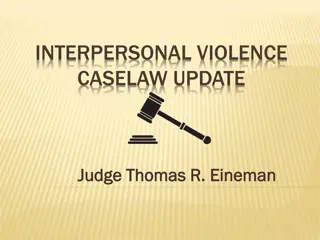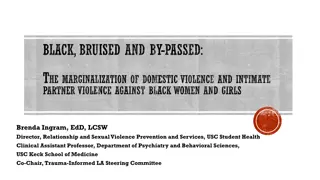Legal Liability for Acts of Violence in Retail: Risks and Case Studies
Legal implications of acts of violence in retail settings, including negligent or inadequate security leading to civil actions. Learn about key terms, concepts, and case studies to understand the risks and responsibilities involved. Delve into the John Doe v. XYZ Retail case to uncover lessons learned from a real-world scenario involving a shooting incident in a retail parking lot.
Uploaded on Mar 04, 2025 | 6 Views
Download Presentation

Please find below an Image/Link to download the presentation.
The content on the website is provided AS IS for your information and personal use only. It may not be sold, licensed, or shared on other websites without obtaining consent from the author.If you encounter any issues during the download, it is possible that the publisher has removed the file from their server.
You are allowed to download the files provided on this website for personal or commercial use, subject to the condition that they are used lawfully. All files are the property of their respective owners.
The content on the website is provided AS IS for your information and personal use only. It may not be sold, licensed, or shared on other websites without obtaining consent from the author.
E N D
Presentation Transcript
LEGAL LIABILITY FOR ACTS OF VIOLENCE IN RETAIL: Understanding the Risks
TODAYS PANELISTS Nathan Brown Corporate Counsel, The Kroger Company Brian Trulock Partner, Bendin Sumrall & Ladner, LLC Walter E. Palmer Executive Vice-President, CAP Index
AGENDA Legal Primer Brief overview of key terms, concepts Case Study - Parking lot shooting, litigation process and verdict, lessons learned Corporate Perspective - Managing across jurisdictions, legal standards Active Shooter Any legal developments in this arena?
NEGLIGENT OR INADEQUATE SECURITY Civil Action (not criminal, OSHA) Tort law (not contract) Negligence (not intentional) Generally, individuals/companies are not liable for criminal acts of third parties Emerged in 1970 s and 80 s as new part of premises liability Headline-grabbing cases in 2019
PRINCIPLES AND TERMS Duty Proximate Cause Cause in Fact Forseeability Prior, similar Totality of circumstances Balancing act Damages Compensatory Punitive Apportionment Relationship Invitee Licensee Trespasser Voluntary assumption Breach Provide reasonable security No bright line rules
John Doe v. XYZ Retail Lessons Learned Brian Trulock
Introduction and Basic Facts December 2012, Plaintiff Mr. Doe shot in the parking lot of a retail location in Atlanta. He was there to engage in a private transaction (sale of electronics) with a third party and to buy eye drops. Immediately after the unsuccessful transaction, an unidentified third person entered Mr. Doe s vehicle, demanded his money, and shot him several times.
Basic Allegations Retailer knew or should have known that a shooting in its parking lot was foreseeable, and it was negligent because it failed to take reasonable measures to guard against it. Specifically, Plaintiff argued Retailer should have had a security guard in place, which would have prevented the shooting.
Defenses Not foreseeable based on previous criminal acts. 2 previous armed robberies and a purse snatching. Not foreseeable because Mr. Doe was targeted, and there was no way Retailer could have had advance knowledge of the criminal conspiracy between buyer and unidentified third party.
How Did Plaintiff Succeed? Thorough work up in discovery. Built an effective story before entering Court. Exploited inconsistencies between levels of authority and lack of knowledge of corporate policies. What came across as a lack of concern for its employees and customers angered the jury, and they ignored the likely criminal conduct in order to punish Retailer through a large compensatory award.
Operations vs. Loss Prevention Ensure everyone is on the same page when it comes to identifying the people responsible for determining what security measures are needed. Someone must be in charge! Security vs. Loss Prevention: Related but different. Someone needs to be responsible for assessing the safety of the store and its customers from third party criminal attacks. Most training at the retail level focuses on loss prevention, very little on preventing third party violence.
Security Guards At the single store level, security guards are not expensive. As a Fortune 500 company, you must be prepared to explain the circumstances which caused placement of a security guard. It must be more than a feeling or the store manager s subjective perception of the area. Develop objective criteria that someone can explain. If you do not use security guards, why not? The average juror will see security guards as an inexpensive precaution.
Security Guards (cont.) Armed vs. unarmed? Off duty police vs. security professional. Post orders and Rules of Engagement Under what circumstances are your guards allowed to intervene? Do firearms increase the potential risk of harm? Whatever decision you make, make sure it is documented and backed by real evidence, and make sure someone is able to explain the decision. Have a way of documenting employee concerns about store safety? Method of direct report instead of relying on store manager?
Parking Lots Should they be open to the public? Many people view parking lots as a safe space to engage in private business transactions. Consider signs indicating parking is for customers only, and that private business transactions are prohibited. Measures that might convert individuals like Mr. Doe into trespassers instead of licensees or invitees.
Apportionment When does it work? Apportionment is likely a successful strategy only when the store has a sound methodology for determining its security precautions. In those cases, jurors are more likely to attribute fault to the criminal actors.
MANAGING ACROSS JURISDICTIONS Jurisdiction/venue matter Know the appellate landscape Use a consistent approach Manage to the data, not the dollars Don t confuse violent acts with property crimes
ACTIVE SHOOTER Claims being made; not very successful Mass shootings have become so common in the US that they are foreseeable in any location that attracts mass gatherings of people. What is mass gathering? FBI says a mass shooting is four people Tacoma Mall shooting 2005 Even assuming foreseeability, can they reasonably be prevented?


